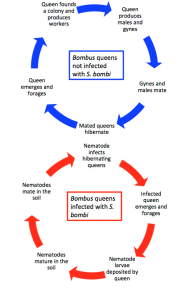Effectively castrated by the nematode Sphaerularia bombi, these queen bumblebees cannot nest
The queen becomes a surrogate mother for the nematode worms
When hibernating in the soil, the fertilised female nematode, Sphaerularia bombi, which only infects bumblebee queens, enters the body of the queen bumblebee and lays her eggs inside her. When the queen emerges in the spring, instead of being capable of founding her own nest site, the nematode alters her behaviour and neuters her making her incapable of nesting. It makes her a surrogate mother for her nematode worms.
Distorted nest seeking behaviour
The queens I saw did show nest seeking behaviour, BUT flew just above the ground, landed, crawled a little, flew away a short distance landed nearby and started digging into the sandy soil underneath twigs, leaves and stones. When nest seeking proper, they explore likely holes in the ground and enter them to recce them further, sometimes flying over a dark object, realise it is not a hole and fly away. These queen did not show this behaviour. The infected queens return to their hibernation site, another behavioural change made on her by the nematode, to deposit the larvae in the queens faeces. This increases the chances of nematodes infecting new queens at hibernation sites.
Hole digging
One queen dug 4 holes in succession all within a few inches of each other. Most of the holes were perhaps only 2 cms or so deep, and just indents into the soil similar to pushing a small twig into the soil. There was no end chamber for a hibernation site or a nest. Simply too shallow. Except for one which almost disappeared under the very friable soil the queen was digging into, it may have been 3cms or so.
The queens dug holes, turned around and I suspect they probably deposited 3rd stage larvae of the nematode in their faeces. You can see this by one queen, as above. By their sometimes clumsy behaviour, time of the year, (these bees should have initiated their own colonies much earlier in the year) so many holes in one area, so many queens in less than an hour, non of which had pollen attached, scrambling over the leaf litter and digging numerous holes, I suspect these queens and the previously dug holes probably, all contained nematode worms. It is known to infect several Bombus species, with B. hypnorum and B. hortorum showing some resistance.
Image by Dr. Catherine Mary Jones taken from link below.
100,000 juveniles
The nematode larvae mature, mate and infect overwintering queens whilst hibernating in likely hibernation sites. As infected queens cannot found their own nest, they are therefore ‘lost’ to the bumblebee world and the colonies they would have established. Infection figures, which can be quite high, may be found in the Jones paper link below. Alford describes the nematode as a formidable enemy and upwards of 100,000 eel-like juveniles may be inside one queen. If the queen bumblebee dies before the larvae are released, e.g. starvation, some larvae can basically go into suspended animation and revive when water rejuvenates them.
Golf course site
The site itself was found on a NE facing oak wooded slope, sparse ground vegetation, sandy friable damp soil with organic matter on the surface and well drained. It was well sheltered by the trees. I will be returning later in the year to see if any healthy queens can be found digging this area itself for their hibernation chambers or not! Can’t wait! This golf course probably contains more bumblebee made holes than the course itself!
Ref: Besides my own observations:
These both can be downloaded
Morphology and Life History of Sphaerularia bombi Poinar and Der Laan
Bumblebees DV Alford
Intersted in Citizen Science and pollinators? (e.g. bees!) The Buzz Club



Hi George
Very interesting reading. Did these nematodes originate from this country or have they been introduced along with So many other suspicious insects? . I do wonder.
Regards as always
Marian
Hi Marian, nice to hear from you. Yep these are native nematodes not alien species. They can have a huge effect on bumblebee queens and therefore bumblebee numbers 🙁 cheers, George….soon be leafcutter season!
Hi George,
These nematodes seem extremely fiendishly efficient.
Do you know if there is some factor that naturally keeps them in check?
I wonder if the “normal” sort of cold winters that we used to get might control them particularly as bumblebees are so efficient at survival when hibernating through such extreme cold and I heard like to hibernate in the ground in a north facing slope.
Do you think global warming might increase the success of these nematodes?
I suppose I should perhaps admire them for managing to seem to get into the bees brains so as to behave in that way but I don’t think I can.
Regards Steve.
They have co evolved with queen bumblebees and been around a long time. I am not sure how much research has been done on them and if global warming may affect them. Hard to say Steve. Clever though eh? Cheers, George